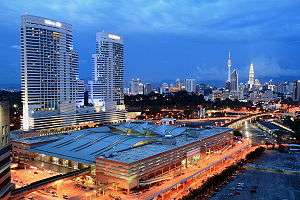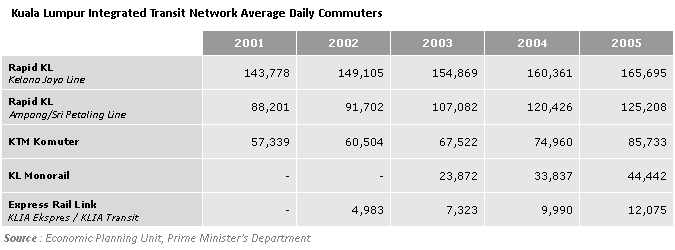Public transport in the Klang Valley

Currently, there is a variety of public transport modes including buses, rail, and taxis serving Kuala Lumpur and the surrounding Klang Valley region. However, Kuala Lumpur, with a population of 1.79 million in the city[1] and 6 million in its metropolitan area,[2] Klang Valley, is experiencing the effects and challenges of rapid urbanisation and urban planning issues.
To resolve these issues, Kuala Lumpur City Hall (KLCH) has plans to initiate programs that would improve the public transportation system and increase the transportation sustainability of Klang Valley. The Kuala Lumpur Structure Plan 2020, in particular, intends to respond to the unprecedented growth and changes of Kuala Lumpur’s urban transportation landscape.[3]
History of public transport in Kuala Lumpur
In the 19th century and early 20th century, most Kuala Lumpur citizens and tin miners used rickshaws, elephants, sampans, and bull- or horse-drawn carriages as basic public transportation (as in transport by means not owned by persons being transported).
From the 1960s to the 1990s, the Mini-Bus Service or Bas Mini was popular.
Local transport
Buses
There are several bus operators operating in Kuala Lumpur, linking the city centre with the suburbs of the Klang Valley. The main operator is Prasarana's subsidiaries of Rapid Bus, who took over the operations of the two main bus operators, Intrakota and Cityliner.
Other operators include Metrobus, Selangor Omnibus, Len Seng, Transnasional/Kenderaan Klang-Banting, Triton, and Permata Kiara.
Rail
The Klang Valley Integrated Transit System consists of two light rapid transit (LRT) lines, two commuter rail lines (along with shuttle services), one monorail line, one bus rapid transit line and an airport rail link to Kuala Lumpur International Airport, which consists of an express and a transit service. The LRT lines connect the city centre with major suburbs like Petaling Jaya, Subang Jaya, Gombak, Puchong and Bukit Jalil. The commuter rail lines link the city centre with Shah Alam, Petaling Jaya, Klang (city), Rawang, Kepong and others. The monorail serves various locations in the city centre. There are several interchange stations that integrate these rail services.
|

Taxis
Metered taxis can be hailed throughout the city. However, traffic jams are fairly common in KL, especially during rush hour, and it might be difficult to get a taxi at that time. There have been many instances of taxi drivers charging extravagant fares, especially for tourists, who are therefore advised to travel in taxis which charge fares according to a meter, and insist that the meter is used.

Transit hubs
Intercity travel

For intercity travel, the main transit hubs in Kuala Lumpur are:
- Pudu Sentral — a major intercity bus terminal located in the city centre. A new bus terminal, Plaza Rakyat is planned to replace neighbouring Pudu Sentral. However, the construction has been halted indefinitely. There is an LRT station nearby that connects the building.
- Putra Bus Terminal — serving buses heading to the East Coast destinations. Nearby rail connections are at PWTC LRT station and Putra Komuter station.
- Pasar Rakyat — a new bus terminal to reduce Pudu Sentral's load.
- KL Sentral — Kuala Lumpur's main railway station.
- Duta Bus Terminal — for buses operated by Transnasional and Airport Coach (bus services to KLIA)
Local rail transport
- KL Sentral — a modern multi-modal transport hub served by KTM Komuter, LRT, KLIA Ekspres and KLIA Transit as well as local buses and those to KLIA
- Masjid Jamek — an LRT interchange between Kelana Jaya line and Ampang line.
- Bandar Tasik Selatan station — a train interchange between the Ampang Line, KTM Komuter service and ERL Transit.
Local bus terminals
KL Sentral, Titiwangsa, KLCC, Maluri, and Medan Pasar form Rapid KL's bus interchanges in the city. Meanwhile, private bus operators are mostly based at the Jalan Tun Tan Cheng Lock (formerly known as Jalan Cheng Lock) area which includes Pasaramakota, Central Market, Bangkok Bank, Medan Pasar, Kotaraya, Sinar Kota and Puduraya.
There are also several suburban bus hubs that serve as terminals and interchanges.
Legacy terminals
Traditionally, most bus services, whether local or intercity originated from the city centre, especially in the areas around Jalan Tun Tan Cheng Lock. Recently transport operators have decided to unilaterally move operations elsewhere. For example, executive bus operators, especially those headed for Singapore, have switched to less congested locations like the Kuala Lumpur Railway Station, KL Sentral, Bangsar and Petaling Jaya. Rapid KL itself has shifted operations to its city hubs. The government meanwhile has been encouraging buses to use other newer terminals like Pasarakyat and Duta Bus Terminal.
The Kuala Lumpur Railway Station ceased to serve intercity trains in 2001 when operations shifted to neighbouring KL Sentral. However, many other operations such as KTM Komuter services and postal services by Pos Malaysia are still maintained there.
Regulation
The public transport system is regulated by various authorities, including the Commercial Vehicle Licensing Board (CVLB) of the Ministry of Entrepreneur and Co-operative Development, the Ministry of Transport and local governments such as the Dewan Bandaraya Kuala Lumpur and the other city and municipal councils.
There is no single body that regulates the whole sector.
The Integration and Restructuring of the Public Transport System in the Klang Valley (Inspak) steering committee, established in July 2003, is tasked with encouraging greater use of public transportation to reduce traffic congestion and initiate the establishment of the Klang Valley Urban Transport Authority as the regulatory authority for public transportation in the Klang Valley. Little has been said about the establishment of this authority ever since.
Rapid KL was established in 2004 by the Ministry of Finance to provide an integrated public transport system in the Klang Valley incorporating rail and bus services as part of Inspak. It holds quasi-regulatory powers in the sense that unlike other bus operators, it has much greater freedom to set its own routes. Furthermore, its fare structure differs from that set by the CVLB.
By 2007, passengers have access to Touch 'n Go ticketing system on RapidKL systems, KL Monorail, and KTM Komuter.[4]
Future expansion and extensions
LRT Extension
On 29 August 2006, Malaysian Deputy Prime Minister Mohd Najib Abdul Razak announced an RM10 billion plan to expand Kuala Lumpur's public transport network. The plan included extending the existing Kelana Jaya Line from Kelana Jaya to USJ and the Ampang Line from Sri Petaling to Puchong and USJ. The plan also will see a new light rail transit line being constructed between Kota Damansara to the northwest of Kuala Lumpur and Cheras which lies to the southeast of Kuala Lumpur.[5] On September 15, 2009, the operator has revealed the alignment and the location of new stations regrading the line extension for public input.
The Star, a local newspaper reported a new 40 km route from Cheras to Kota Damansara which traverse the city center through Bangsar, KL Sentral, Pasar Seni and Masjid Jamek stations. The new line is expected to be ready by 2012, however, as of July 2009, no construction has started.[6]
On June 2010, Prime Minister Dato' Seri Najib Tun Razak announce plans to build three Mass Rapid Transit lines which compromise a Sungai Buloh to Cheras, Sungai Buloh to Serdang and a loop line around the city's edges. Length of the lines is to be between 180 kilometers to 200 kilometers with a carrying capacity of 2 million people a day. Expected cost of the project is RM36 billion. It is not sure whether the line is part of the Kota Damansara-Cheras Line or a completely new line.[7][8]
Klang Valley Mass Rapid Transit System
A 156 km long mass rapid transit system will be built within 20 km radius from the city center under the 10th Malaysia Plan and Economic Transformation program. The system consists of three lines, each will be integrated to current rail systems in Kuala Lumpur. The three new lines are expected to cost RM35 billion, making it one of the most expensive projects in Malaysia's history.[9]
Klang Valley Bus Rapid Transit System
One of the 11 initiatives under the NKRA-UPT, the bus rapid transit (BRT) networks in Klang Valley initiative is being implemented by the Suruhanjaya Pengangkutan Awam Darat (SPAD). SPAD has recognized 12 BRT corridors in Klang Valley Public Transport Master Plan-Draft (2010) under Bus Transformation Plan section. One of BRT Corridor currently under construction is BRT Sunway Line. The proposed BRT KL–Klang has been identified in KL BRT Report 2011 as one of the potential BRT Corridors and this BRT project is planned to be operational by 2016. [10]
Recent efforts
Recent efforts on urban transportation design addresses both the functional and aesthetic aspects of the city’s built environment. The Kuala Lumpur Structure Plan 2020 particularly cites good transportation linkage as essential factors to the success of the city, noting that public transportation would enable greater flexibility and movement. For the residents of Kuala Lumpur, it is important to provide transportation structure that allows members of the community equal accessibility. The KLCH recognizes “low public transport modal share”[11] as the key problem to high demands on road infrastructure and traffic congestion.
In an effort to increase public transportation usage, KLCH is currently expanding and constructing the Mass Rapid Transit lines that would provide more coverage to areas within the conurbation. Additional attention to the design of the newest public transport facilities is made to accommodate individuals with special needs. Also, to avoid traffic congestion occurring on local streets, major bus and rail interchange stops will be strategically located at points of intersections of major roads.[12]
See also
References
- ↑ "Department of Statistics Malaysia Official Portal". www.statistics.gov.my. Retrieved 2016-11-14.
- ↑ "KL on track to megacity status". focusmalaysia.my. Retrieved 2016-11-14.
- ↑ Emizul. "KLCH Strategic Plan". www.dbkl.gov.my. Retrieved 2016-11-14.
- ↑ Rapid KL Launches Integrated Smart Card Ticketing System
- ↑ Mergawati Zulfakar (30 August 2006). "Rail travel expansion". The Star. Retrieved 2007-06-22.
- ↑ Leong Shen-Li (2008-06-15). "Kota Damansara-Cheras rail line right on track". The Star. Retrieved 2008-07-05.
- ↑ CIMB Research (2010-06-14). "Construction Sector (CIMB Research); maintain overweight". The Edge Daily.
- ↑ Razak, Najib (2010-06-10). The Tenth Malaysia Plan, 2011–2015 (PDF) (Speech). Dewan Rakyat, Kuala Lumpur, Malaysia. Retrieved 2010-06-15.
- ↑ "KL to get landmark MRT in world-class city bid". Retrieved 2010-09-26.
- ↑ "SPAD MasterPlan" (PDF). 2013-11-07.
- ↑ "Kuala Lumpur Structure Plan 2020 : Transportation". www.dbkl.gov.my. Retrieved 2016-11-14.
- ↑ Emizul. "KLCH Strategic Plan". www.dbkl.gov.my. Retrieved 2016-11-14.
External links
- Kuala Lumpur Mass Rapid Transit Website (KL MRT Website)
- iMetro - Interactive transport guide of Kuala Lumpur transport system